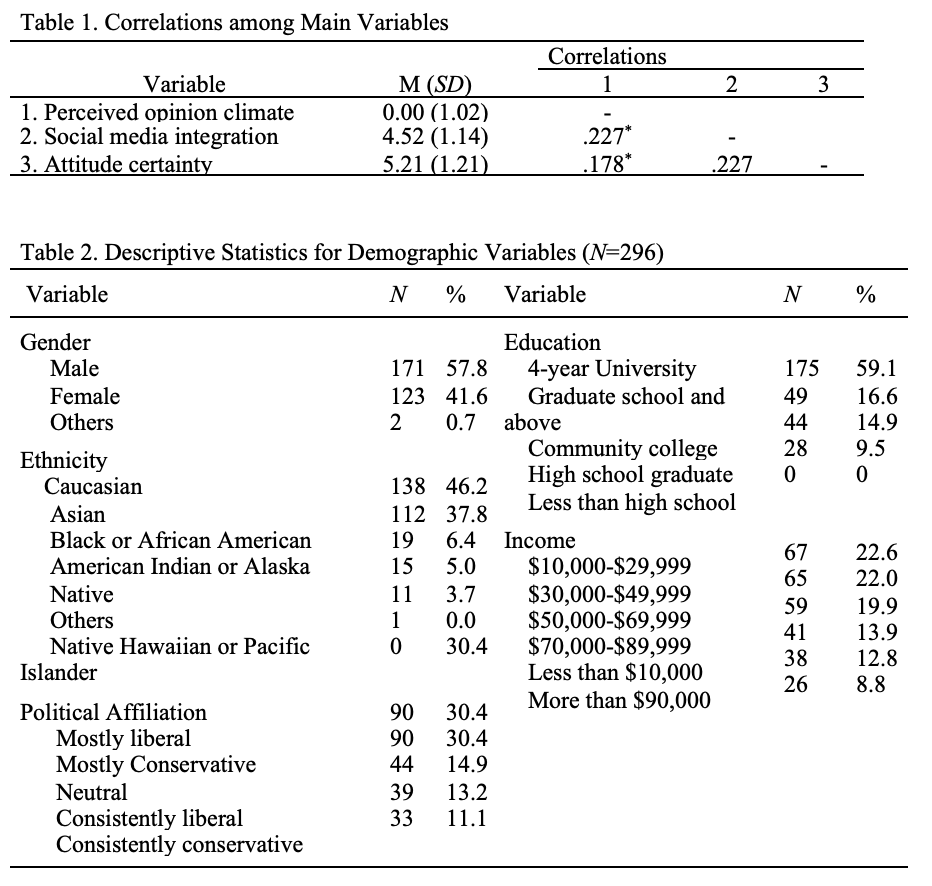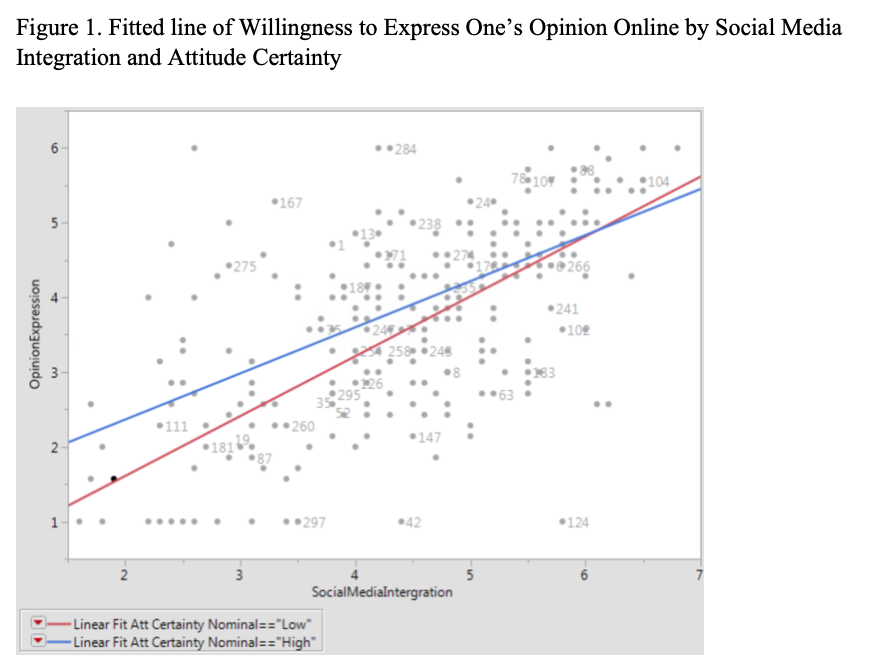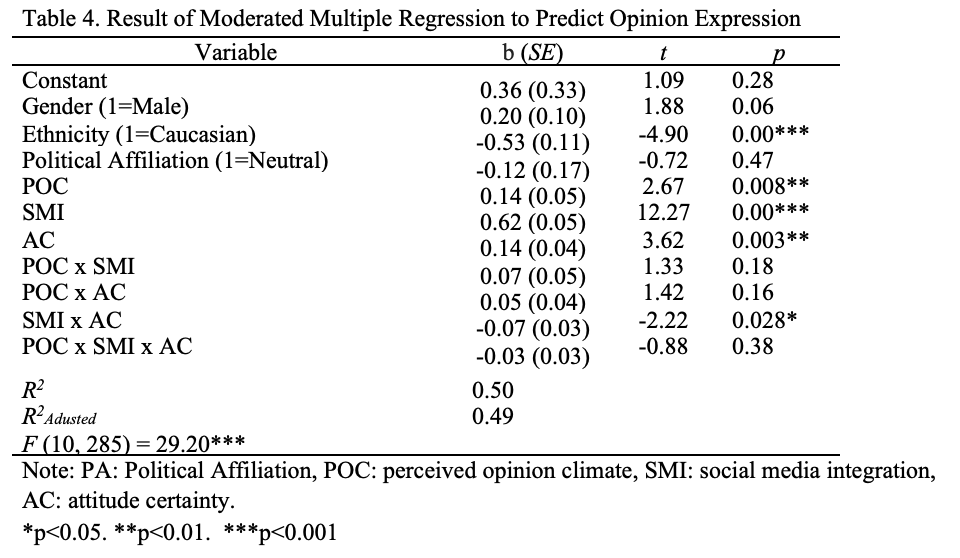Media Effects Research Lab - Research Archive
Spiral of silence on social media:
Student Researcher(s)
Lola Xie (Ph.D Candidate);
Meng-Qi (Maggie) Liao (Masters Candidate);
Nahyun Kim (Ph.D Candidate);
Faculty Supervisor
This paper was based on a project as part of the Comm 506 course.
INTRODUCTION
This study primarily attempts to fill the gap in spiral of silence research by adopting the concept of social media integration and attitude certainty. Spiral of silence provides a useful framework to examine how the public opinion is formed. As one of the most controversial public issues (Bliuc, McGarty, Thomas, Lala, Berndsen & Misajon, 2015), climate change issue was selected to be the context of this study.
RESEARCH QUESTION / HYPOTHESES
1) The relationship between perceived opinion climate and willingness to express one’s opinion
RQ1: For the general population in the US, controlling for gender, ethnicity, and political affiliation, what is the relationship between their perceived opinion climate about the climate change issue (reality) and their willingness to express their opinions towards the issue?
2) The moderating role of social media integration and attitude certainty in the spiral of silence process on social media
H1: People’s level of attitude certainty will be a positive predictor of their level of willingness to express opinions about climate change issues.
H2: The relationship between people’s perceived opinion climate about climate changes issues (reality) and the willingness to express their opinions about climate change issues will be moderated by people’s level of attitude certainty towards climate change issues.
3) The main effect of social media integration and attitude certainty in the spiral of silence process on social media
RQ2: For the general population in the US, controlling for gender, ethnicity, and political affiliation, what is the relationship between their level of social media integration and their willingness to express their opinions towards the climate change issue?
H3: The relationship between people’s perceived opinion climate about climate change issues (reality) and the willingness to express their opinions about climate change issues will be moderated by people’s level of social media integration.
4) How the opinion climate, social media integration and attitude certainty together influence one’s willingness to express their opinion publicly on social media.
RQ3: For the general population in the US, controlling for gender, ethnicity, and political affiliation, what is the interaction effect of their perceived opinion climate, level of social media integration, level of attitude certainty on their willingness to express their opinions towards the climate change issue?
METHOD
An online survey was conducted to test the proposed model with a sample of 296 respondents (after removing the four uncompleted questionnaires from the original 300 participants) recruiting from Amazon Mechanical Turk in November 2018. Detailed demographic information of participants is listed in Table 2.
 7-point Likert scales were adopted to measure the dependent variable Willingness to express opinion (α=0.92, M=3.76, SD=1.25), and independent variable Social Media Integration adopted from Jenkins-Guarnieri, Wright and Johnson (2013) (α=0.87, M=4.53, SD=1.14), as well as Attitude Certainty adopted from Petrocelli, Tormala and Rucker (2007) (M= 5.21, SD=1.52). Perceived opinion climate was constructed towards comparing individual opinion toward climate change and perceived opinions of others (friend/family or nation) towards climate.
7-point Likert scales were adopted to measure the dependent variable Willingness to express opinion (α=0.92, M=3.76, SD=1.25), and independent variable Social Media Integration adopted from Jenkins-Guarnieri, Wright and Johnson (2013) (α=0.87, M=4.53, SD=1.14), as well as Attitude Certainty adopted from Petrocelli, Tormala and Rucker (2007) (M= 5.21, SD=1.52). Perceived opinion climate was constructed towards comparing individual opinion toward climate change and perceived opinions of others (friend/family or nation) towards climate.
A moderated multiple regression analysis for willingness to express one’s opinion on social media was conducted controlling gender, ethnicity, and political affiliation.
RESULTS
The perceived opinion climate was a significant predictor of willingness to express one’s opinion on social media (B=.15, P<0.01). For the relationship between perceived opinion climate and willingness to express one’s opinion on social media, moderating effects of social media integration (B=0.06, P=0.26) and attitude certainty (B=.05, P=0.16) did not appear to be significant. However, regarding willingness to express one’s opinion on social media, social media integration (B=0.61, P<0.01) and attitude certainty (B=1.21, P<0.05) showed a significant main effect, as well as the interacting effect between the two moderating variables (B=-.70, P<0.05) (See Figure 1). Finally, the three-way interaction by perceived opinion climate, social media integration, and attitude certainty was not significant (B=-.03, P=.39). Detailed description of the regression coefficients for the variables is included in Table 4.


CONCLUSIONS/DISCUSSION
The result supported the theory of spiral of silence confirming the influence of perceived opinion climate on one’s expressive behavior. Social media integration appeared to be the most significant predictor for one’s opinion expression on social media followed by attitude certainty and perceived opinion climate. For those with low attitude certainty, they are less likely to express their opinion on social media than those with high attitude certainty when there’s no social media integration for both groups. Interestingly, however, as social media integration increases, those with low attitude certainty become more vocal and eventually exceed those with high attitude certainty when both groups are highly integrated with social media. The result demonstrates the importance of social media integration in understanding whose opinion is more likely to swirl up to the public opinion.
REFERENCES
Bliuc, A., McGarty, C., Thomas, E., Lala, G., Berndsen, M., & Misajon, R. (2015). Public division about climate change rooted in conflicting socio-political identities. Nature Climate Change, 5(3), 226-229. doi:10.1038/NCLIMATE2507
Jenkins-Guarnieri, M. A., Wright, S. L., & Johnson, B. (2013). Development and validation of a social media use integration scale. Psychology of Popular Media Culture, 2(1), 38-50. doi:10.1037/a0030277
Petrocelli, J. V., Tormala, Z. L., & Rucker, D. D. (2007). Unpacking attitude certainty: Attitude clarity and attitude correctness. Journal of Personality and Social Psychology, 92, 30-41. doi: 10.1037/0022-3514.92.1.30
For more details regarding the study contact
Dr. S. Shyam Sundar by e-mail at sss12@psu.edu or by telephone at (814) 865-2173

